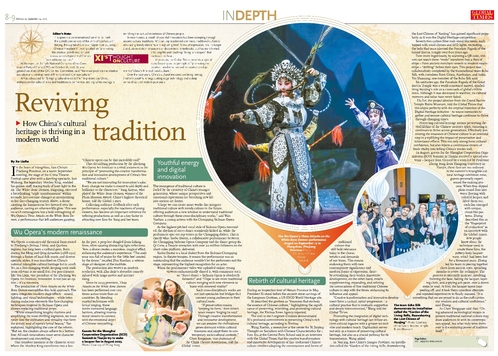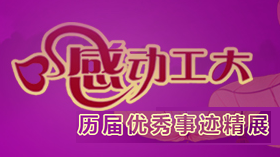
Global Times丨Reviving tradition: How China’s cultural heritage is thriving in a modern world

Reviving tradition: How China’s cultural heritage is thriving in a modern world
Xu Liuliu
Editor's Note:
In a speech at an international seminar to mark the 2,565th anniversary of the birth of Confucius in Beijing, the capital of China on September 24, 2014, Chinese President Xi Jinping called on "promoting the creative transformation and innovative development of China's fine traditional culture."
At the report at the 19th National Congress of the Communist Party of China (CPC) on October 18, 2017, Xi, also general secretary of the CPC Central Committee, said "We must promote the creative evolution and development of fine traditional Chinese culture."
Xi has advocated for "bringing cultural relics to life." In present-day China, enthusiasm for cultural relics and traditions is on the rise, and digital technology is enriching the cultural experience of Chinese people.
In recent years, a breath of youthful innovation has been sweeping through ancient cultural traditions. With an unprecedented openness, traditional culture is embracing trendy elements and exploring fresh forms of expression. It is no longer just dusty exhibits in museums or distant texts in textbooks, but has transformed into tangible and touching "living landscapes" that captivate the heart.
Eleven years on, the Global Times presents a special story focusing on the principle of "promoting the creative transformation and innovative development of China's fine traditional culture."
Over the past years, China's cultural treasures are being reimagined with youthful energy, cutting-edge technology, and a deep sense of cultural pride in past years.
The team Echo Silk demonstrate its installation called the
In the heart of Hangzhou, East China's Zhejiang Province, on a warm September evening, the stage of the China Theatre Festival came alive with a dazzling spectacle. Sun Wukong, the legendary Monkey King, wielded his golden staff, tracing trails of laser light in the air. The White Bone Demon, Baigujing, executed a breathtaking "triple transformation" within seconds, her costume changes as mesmerizing as her face-changing artistry. Above, a drone carrying the luminescent bee hovered over the audience, casting an otherworldly glow. This was no sci-fi extravaganza but a bold reimagining of Wu Opera's Three Attacks on the White Bone Demon, a performance that left audiences gasping, "Chinese opera can be this incredibly cool!"
This electrifying production by the Zhejiang Wu Opera Art Institute is a vivid testament to the principle of "promoting the creative transformation and innovative development of China's fine traditional culture."
"We are not innovating for innovation's sake. Every change we make is meant to add depth and brilliance to the characters," Yang Xiayun, who played the White Bone Demon, winner of the Plum Blossom Award, China's highest theatrical honor, told the Global Times.
Collecting audience feedback after each performance, especially the reactions of young viewers, has become an important reference for refining productions as well as a key factor in attracting new fans for Yang and her team.
Wu Opera's modern renaissance
Wu Opera, a centuries-old theatrical form rooted in Zhejiang's Jinhua, Lishui, and Quzhou regions, has long been a cultural gem. Born during the Ming and Qing dynasties (1368-1911) through a fusion of local folk music and diverse operatic styles, it was inscribed on China's national intangible cultural heritage list in 2008. Yet, in a fast-changing world, keeping such traditions relevant is no small feat. For practitioners like Yan Lixin, vice president of the Zhejiang Wu Opera Art Institute, innovation is not just an option - it's a necessity.
The production of Three Attacks on the White Bone Demon exemplifies this bold approach. The opera integrates modern stage effects - sound, lighting, and visual technologies - while introducing audacious elements like face-changing techniques inspired by Sichuan Opera and drones replacing traditional props.
"While streamlining lengthy rhythms and amplifying the most thrilling segments, we must never lose the stylization and virtuality that form the artistic soul of opera's lyrical beauty," Yan explained, highlighting the core of the reform. "But we, the creators always adhere to a bottom line: All such innovations must serve character development and storytelling."
One standout moment is the climactic scene where the Monkey King transforms into a bee. In the past, a prop bee dangled from fishing lines, often causing distracting light reflections. Now, a drone creates a seamless, magical effect, enhancing the audience's experience. "The audience was full of praise for the 'little bee' created by the drone," recalled Zhu Xiaobao, a veteran stage art designer at the institute.
The production also weaves in modern aesthetics, with Zhu Bajie's absurdist comedy infused with tango moves and internet slang.
Since its 2023 premiere, Three Attacks on the White Bone Demon has been performed over 100 times across more than 20 countries. By blending martial techniques with lyrical singing, these works transcend language barriers, allowing international viewers to connect with the emotional depth of Chinese storytelling.
Youthful energy and digital innovation
The resurgence of traditional culture is fueled by the creativity of China's younger generation, whose unique perspectives and emotional expressions are breathing new life into ancient art forms.
"I hope we can create more works that integrate traditional culture with trendy culture in the future, offering audiences a new window to understand traditional culture through these cross-disciplinary works," said Wan Yuehan, a young actress with the Chongqing Sichuan Opera Company.
As the highest-pitched vocal style of Sichuan Opera resounded, the rhythm of street dance seamlessly kicked in, while the performers spat out rap verses in the Chongqing dialect. This is exactly what Yaobu Daotai, a collaborative performance between the Chongqing Sichuan Opera Company and the dance group Bu Qi Crew, a Douyin sensation with over 20 million followers on the short video platform, delivered.
Yaobu Daotai is a local dialect from the Sichuan-Chongqing region. In theater troupes, it means the performance was so outstanding that the audience wouldn't let the performers exit the stage, representing the highest recognition for an actor.
When the performance video was uploaded online, young viewers enthusiastically shared it, with comments such as: "Street dance + Sichuan Opera is absolutely fantastic!" and "Hope to see more traditional culture merging with new elements to burst with renewed vitality!"
Such cross-disciplinary works are not just spectacles but bridges that connect young audiences to their cultural roots.
"If preservation means 'keeping its form,' then inheritance means 'forging its soul.' Through creative transformation and innovative development, we can awaken the civilizational genes dormant within cultural treasures and adapt them to contemporary socio-cultural contexts," Chen Yongquan, vice chairman of the China Theatre Association, told the Global Times.
Rebirth of cultural heritage
During an inspection tour of Henan Province in May, President Xi stood before the ancient stone carvings of the Longmen Grottoes, a UNESCO World Heritage site.
Xi described the grottoes as "treasures that embody the essence of Chinese culture," highlighting the significance of preserving, inheriting, and promoting cultural heritage, the Xinhua News Agency reported.
The visit to the Longmen Grottoes demonstrated Xi's profound commitment to preserving China's rich cultural heritage, according to Xinhua.
Wang Xuebin, a researcher at the center for Xi Jinping Thought on Socialism with Chinese Characteristics for a New Era at the Central Party School said in an interview with the Global Times that the creative transformation and innovative development of fine traditional Chinese culture involves adapting the connotations and forms of traditional culture that still hold relevance today to the characteristics and demands of our times. This means endowing them with new contemporary significance and modern forms of expression, thereby revitalizing their vitality. Innovative development, on the other hand, entails supplementing, expanding, and refining the connotations of fine traditional Chinese culture in step with the times, enhancing its influence and appeal.
"Creative transformation and innovative development form a cyclical, spiral progression - a cultural practice that is mutually supportive and deeply interconnected," Wang told the Global Times.
Promoting the integration of digital technology with cultural heritage can infuse ancient cultural legacies with a greater sci-tech vibe and modern touch. Digitization serves not only as a means of preserving cultural heritage, but also as a crucial pathway for its transmission, Wang added.
In Nanjing, East China's Jiangsu Province, an installation called the "Garden of the Living Bells, Reawakening the Lost Chimes of Nanjing" has gained significant popularity as it won the Digital Heritage competition.
Seventy-two carbon fiber rods stand like reeds, each topped with wind chimes and LED lights, recreating the bells that once adorned the Porcelain Pagoda of the Grand Bao'en Temple over 600 years ago.
Even more ingeniously, by scanning a QR code, visitors can watch these "reeds" transform into a fleet of ships - from ancient merchant vessels to modern steamships - "drifting" before their eyes. This project was collaboratively completed by the transnational team Echo Silk, with members from China, Azerbaijan, and India, Yin Shaoyang, one member of the Echo Silk said.
Six centuries ago, the Porcelain Pagoda of the Great Bao'en Temple was a world-renowned marvel, symbolizing Nanjing's role as a crossroads of global civilizations. Although it was destroyed in wartime, its cultural memory and value have never faded.
Hu Lei, the project director from the Grand Bao'en Temple Ruins Museum, told the Global Times that this aligns perfectly with the original intention of the Digital Heritage initiative - to weave memories together and ensure cultural heritage continues to thrive through changing times.
Protecting cultural heritage means preserving the vital lifeline of the Chinese nation's spirit, ensuring it continues to thrive across generations. Effectively promoting the treasures of Chinese culture is an essential step in amplifying the impact of preservation and inheritance efforts. This not only strengthens cultural confidence, but also injects a continuous stream of fresh vitality into telling China's stories well.
In August, guests for the Shanghai Cooperation Organization (SCO) Summit in Tianjin received a special souvenir - lacquer fans. Created by a team led by Professor Zheng Yong from Tiangong University in Tianjin, these fans are not ordinary.
At the summit's intangible cultural heritage exhibition zone, guests personally experienced the making process: When they dipped plain round fans into water floating with colorful lacquer and lifted them out, each fan emerged with unique, cloud-like patterns. Zheng described this as the "fingerprint of civilization" in an interview with the Global Times.
Few people know about the technique used to create these fans, the pottery-body lacquerware, which had been lost for a thousand years. Zheng led his team in piecing together clues from ancient texts, spending months to revive the technique. The process is extremely intricate, involving forming the base, baking the lacquer, layering cloth, and applying ash paste, over a dozen steps in total. At first, the lacquer layers kept peeling off, and it took them countless attempts and repeated experiments to finally succeed. "It is something that we are proud to do as the craft carries our wisdom and cultural confidence," said Zheng.
As Chen Yongquan said that: "Using advanced technological means to present traditional national culture may draw audiences in with its contemporary appeal, but what truly wins them over is the enduring power of tradition itself."

